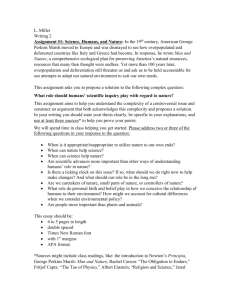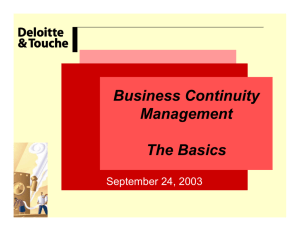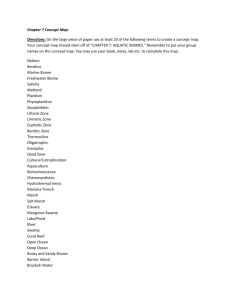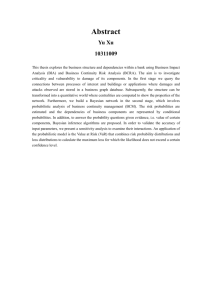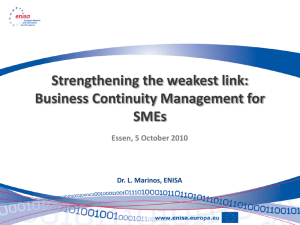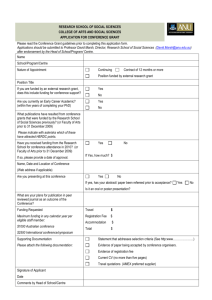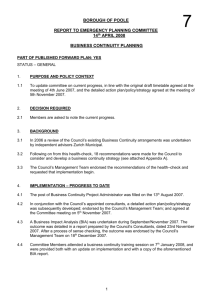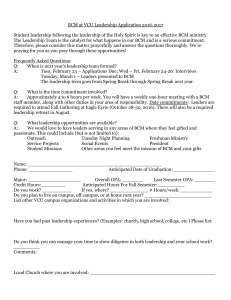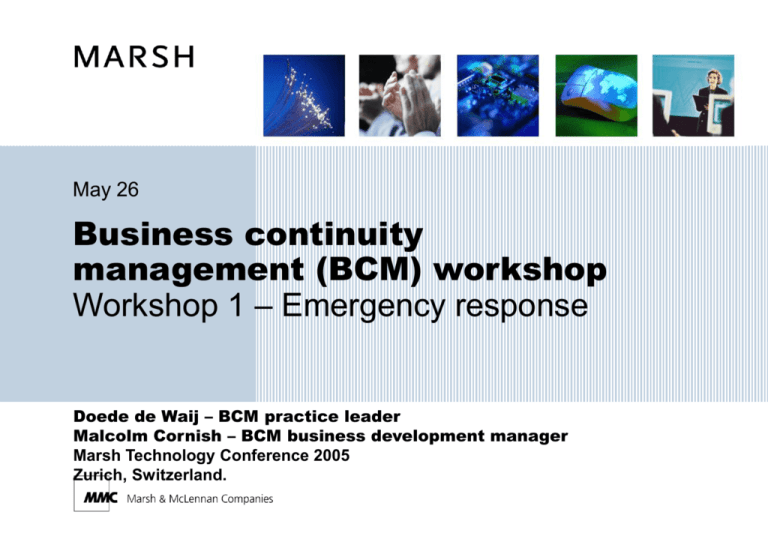
May 26
Business continuity
management (BCM) workshop
Workshop 1 – Emergency response
Doede de Waij – BCM practice leader
Malcolm Cornish – BCM business development manager
Marsh Technology Conference 2005
Zurich, Switzerland.
Agenda
Introduction to workshop
Presentation and background briefing
Scenario review and facilitated discussion
– Move 1
Emergency response
Marsh
2
Business continuity management
Introduction
Malcolm Cornish FBCI
BCM business development manager
What is BCM?
Business Continuity Institute (BCI) and PAS 561
– holistic management process
– identifies potential impacts
– framework for resilience and response capability
– safeguard interests of key stakeholders
or more simply…
A process that establishes a secure and resilient business
environment capable of mounting an immediate and effective
response to a major incident.
Not just a paper plan, it also requires organisation, planning,
assessment, training, rehearsal and more.
1 PAS
Marsh
56 – Guide to Business Continuity Management is a Publicly Available
Specification developed through the British Standards Institution.
4
Objective of business continuity management
Level of business
Fully tested
effective BCM
No BCM –
‘lucky’ escape
No BCM –
likely outcome
Marsh
Critical
recovery point
Time
5
The business continuity plan
Emergency
response plan
A successful
outcome
Crisis management/
communication plan
A
Activity
Business
recovery plan
Marsh
6
Emergency response
Establishing a capability to protect people and
business
Doede de Waij, MBCI
BCM practice leader
Why emergency response?
Safeguard employees, visitors,
and public
Protect physical assets
(buildings and equipment)
Minimise damage and
business impact
Avoid environmental
contamination
Protect reputation and image
Ensure regulatory compliance
Good corporate governance
Marsh
8
Threat assessment
What to plan for?
High
Impact
Continuity risks
Accept
(Daily)
Management
Low
Marsh
High
Frequency
9
Emergency response plan
Recognition
Evaluation
(Analysis)
Plan execution
Strategy
(Problem solving)
Communicate
Debrief
Preparation
Determine
availability &
capabilities of
external
resources
Marsh
ER
structure
Evacuate
Shelterin-place
Security
Rescue
First Aid
Assess
damage
Fight fire
Haz-Mat
Conserve
property
Internal
comms
CM
interface
Media
comms
Stand-down Team
Claims processing
Determine
availability &
capabilities of
internal
resources
Notification criteria
Activation criteria
Assess
incident
Threat
Assessment
External
comms
Time
10
Your head office, where you are now situated accommodates 600
employees. It is a six-storey building on the brand new £400m
FastCentral Business Park next to the A40 west of London.
Yours is the first building to be occupied.
Scenario
Move 1
Wind direction
Chemical vapour cloud is moving towards your head office building.
Cause of release and exact type of chemical are unknown.
Move 1 – Questions
What are your most urgent priorities at this time?
What information and authority do you need to determine protective
actions?
Do you shelter employees in place, or do you begin evacuation
immediately? If you decide to evacuate, where will you move your
employees?
Describe the team structure that you would need to establish in order
to execute the protective actions. What authority must be vested in
the team leader, and why?
Marsh
12
Move 1 – Emergency response
Plenary session
May 26
Business continuity
management (BCM) workshop
Workshop 2 – Crisis management
Malcolm Cornish – BCM business development manager
Doede de Waij – BCM practice leader
Marsh Technology Conference 2005
Zurich, Switzerland.
Agenda
Introduction to workshop
Presentation and background briefing
Scenario review and facilitated discussion
– Move 2
Crisis management
Marsh
15
Business continuity management
Introduction
Malcolm Cornish FBCI
BCM business development manager
What is BCM?
Business Continuity Institute (BCI) and PAS 561
– holistic management process
– identifies potential impacts
– framework for resilience and response capability
– safeguard interests of key stakeholders
or more simply…
A process that establishes a secure and resilient business
environment capable of mounting an immediate and effective
response to a major incident.
Not just a paper plan, it also requires organisation, planning,
assessment, training, rehearsal and more.
1 PAS
Marsh
56 – Guide to Business Continuity Management is a Publicly Available
Specification developed through the British Standards Institution.
17
Objective of business continuity management
Level of business
Fully tested
effective BCM
No BCM –
‘lucky’ escape
No BCM –
likely outcome
Marsh
Critical
recovery point
Time
18
The business continuity plan
Emergency
response plan
A successful
outcome
Crisis management/
communication plan
A
Activity
Business
recovery plan
Marsh
19
Crisis management
Is your company ready to deal with a crisis?
Doede de Waij, MBCI
BCM practice leader
The value of crisis management
IMPACT
Crisis
event
Lost time/productivity
With
Marsh
crisis management
Negative impact
It reduces the
negative impact
and speeds
recovery from
all kinds of
corporate
crises
Without
crisis management
Time
Damage to
financial results,
reputation and
key relationships
21
Major crisis for mobile-phone giants
Source: Logistics Europe February 2004
Background
– Booming mobile phone industry
– Philips semiconductor plant in Albuquerque
(USA)
– Produced mobile phone chips, crucial
components
– 40% of output to:
Nokia, Finland
Ericsson, Sweden
The incident
– Furnace fire caused by lightning bolt
– Brought under control in minutes
– Smoke and water damage
The impact
– Flow of chips suddenly stopped
– Weeks to get plant up to capacity
Nokia
• Monitored supply chain
• Took immediate action to secure supply
• Reconfigured manufacturing to accommodate
different specification
Ericsson
• Took supplier word that not a major problem
• Delayed taking remedial action (2 weeks)
Marsh
22
Crisis management plan
Recognition
Evaluation
(Analyse)
Strategy
(issues &
Implications)
Plan Execution
Communicate
Debrief
Preparation
1st.
Actions
Agenda
Strategy
General
Loss of life
Humanitarian
Stakeholders
Market &
trading
Legal &
finance
Strategy
Info
share &
tracking
Consistent
Message
Internal
comms
Media
comms
Reputation
Product
recall
Team
replace
ment
Stand-down Team
Claims processing
Identify
functional /
stakeholders
interface
requirements
Notification criteria
Activation criteria
Identify
stakeholder /
contingency
issues
Holding
Statement
External
comms
Terrorism
Marsh
Time
23
Your head office, where you are now situated accommodates 600
employees. It is a six-storey building on the brand new £400m
FastCentral Business Park next to the A40 west of London.
Yours is the first building to be occupied.
Scenario
Move 1
Wind direction
Chemical vapour cloud is moving towards your head office building.
Cause of release and exact type of chemical are unknown.
Your head office, where you are now situated accommodates 600
employees. It is a six-storey building on the brand new £400m
FastCentral Business Park next to the A40 west of London.
Yours is the first building to be occupied.
Scenario
Move 2
Wind direction
Chemical vapour cloud has moved west towards your building.
Roads are gridlocked. Vapour is hydrochloric acid. Staff have been
overcome.
News reports suggest terrorists are responsible.
Move 2 – Questions
How are you going to contact and account for employees? What
internal and external stakeholders do you need to communicate with?
How should they be prioritised?
How (what method) will you communicate with employees? How will
you support injured employees and their families; especially those
who lose loved ones during the crisis?
How will you respond to and manage the media? What are the
possible legal and public relations implications and who will resolve
them?
What are the potential long-term implications for your business?
Marsh
26
Move 2 – Crisis management
Plenary session
May 26
Business continuity
management (BCM) workshop
Workshop 3 – Business recovery
Doede de Waij – BCM practice leader
Malcolm Cornish – BCM business development manager
Marsh Technology Conference 2005
Zurich, Switzerland.
Agenda
Introduction to workshop
Presentation and background briefing
Scenario review and facilitated discussion
– Move 3
Business recovery
Marsh
29
Business continuity management
Introduction
Doede de Waij, MBCI
BCM practice leader
What is BCM?
Business Continuity Institute (BCI) and PAS 561
– holistic management process
– identifies potential impacts
– framework for resilience and response capability
– safeguard interests of key stakeholders
or more simply…
A process that establishes a secure and resilient business
environment capable of mounting an immediate and effective
response to a major incident.
Not just a paper plan, it also requires organisation, planning,
assessment, training, rehearsal and more.
1 PAS
Marsh
56 – Guide to Business Continuity Management is a Publicly Available
Specification developed through the British Standards Institution.
31
Objective of business continuity management
Level of business
Fully tested
effective BCM
No BCM –
‘lucky’ escape
No BCM –
likely outcome
Marsh
Critical
recovery point
Time
32
The business continuity plan
Emergency
response plan
A successful
outcome
Crisis management/
communication plan
A
Activity
Business
recovery plan
Marsh
33
Business recovery
Recovering your business before it’s too late
Malcolm Cornish, FBCI
BCM business development manager
Business recovery and disaster recovery
Business recovery
The recovery of the business processes needed to maintain an
acceptable level of operations in the event of significant interruptions
to normal business
Disaster recovery
The technical or IT portion of the Business Recovery
Includes: Mainframe, Midrange (VAX, AS/400), Client Server
(UNIX, NT, etc.)
Disaster recovery is a component of business continuity
Marsh
35
Normal operations
Processes
Business Units
Marsh
36
Business recovery solution
Work Area
Business Units
Computer Centre
DATA STORAGE
Back Up
Mirroring
Objectives
Processes
INFORMATION
TECHNOLOGY
Computer Equipment
Communications
Operating Systems
Applications
Suppliers
Recovery
Teams
Customers
Control Centre
Marsh
37
Your head office, where you are now situated accommodates 600
employees. It is a six-storey building on the brand new £400m
FastCentral Business Park next to the A40 west of London.
Yours is the first building to be occupied.
Scenario
Move 1
Wind direction
Chemical vapour cloud is moving towards your head office building.
Cause of release and exact type of chemical are unknown.
Your head office, where you are now situated accommodates 600
employees. It is a six-storey building on the brand new £400m
FastCentral Business Park next to the A40 west of London.
Yours is the first building to be occupied.
Scenario
Move 2
Wind direction
Chemical vapour cloud has moved west towards your building.
Roads are gridlocked. Vapour is hydrochloric acid. Staff have been
overcome.
News reports suggest terrorists are responsible.
Your head office, where you are now situated accommodates 600
employees. It is a six-storey building on the brand new £400m
FastCentral Business Park next to the A40 west of London.
Yours is the first building to be occupied.
Scenario
Move 3
Wind direction
Chemical vapour cloud carried about five miles and contaminated
your building, which has been closed indefinitely. Fourteen
employees have been hospitalised. One died of heart attack.
Executive board is dealing with the media. As senior managers, you
have to get the business up and running.
Move 3 – Questions
How do you contact your most important customers, business partners and
other stakeholders?
What are the immediate needs to address continuity of business operations?
How do you relocate people and/or processes? What are the implications for
your service and operational levels?
What resources do you need, when do you need them and how do you obtain
them? Since your recovery resources are constrained (you do not have all the
people, facilities and equipment you would like to have), how do you establish
your recovery priorities to meet your business priorities?
How will your business and operational processes work in an environment
where systems, data, and specialised equipment are either not available in
the short term or the long term, (or for IT potentially not backed-up or in sync)?
Marsh
41
Move 3 – Business recovery
Plenary session
May 26
Business continuity
management (BCM) workshop
Final wrap up
Malcolm Cornish – BCM Business Development Manager
Doede de Waij – BCM Practice Leader
Marsh Technology Conference 2005
Zurich, Switzerland.
Be prepared
Business continuity plan
Emergency
Response
• Initial control of emergency
situation
Crisis
• Blue light services –
Management
safeguarding human life
• Stabilising, security, damage
• Strategic direction/policy
assessment
issues
Business
• Crisis communications –
Recovery
internal and external (media)
• Outward facing liaison • Phased recovery of
stakeholders, users etc
business-critical processes
• Co-ordination of service
recovery efforts
Disaster
Recovery
Marsh
• Recovery of infrastructure
and services
• Returning to “business as
normal”
44
BCM methodology
BCM programme management – driven top-down by executive
management ensuring ownership and establishing policy.
Managed at corporate/operational and operational/facility levels.
Measure results through auditing,
exercising, maintenance and training.
Support continuous improvement
through constructive feedback.
Identify overall strategic objectives, values
and activities; identify stakeholders, business
processes, products and services
BCM
programme
management
Develop business continuity plans in
line with agreed strategies; embed
BCM within culture of the
organisation.
Marsh
Analyse financial and non-financial
business impacts resulting from
disruption of business processes (BIA);
identify business-critical processes;
identify gaps in recovery capability;
develop prioritised recovery timeline.
Design appropriate levels of recovery strategies that provide practical, costeffective solutions to close the gaps; design organisational structure to
implement the formulated strategic objectives and operating model to
respond to major incidents.
45
Marsh’s BCM services
BCM consultants
– 100+ (Global)
– 32 (Europe)
Plan development
Business continuity audit
Training and exercising
World’s leading risk and insurance
services firm
Business recovery plan
Combine risk management
and business interruption
strategies
Crisis management plan
Emergency response plan
Proven methodology
Continuity strategy design
and development
Business impact analysis
and risk assessment
– visual and action-orientated
Awareness and
programme definition
– familiar Microsoft products
Marsh’s
business continuity
management services
BCM programme management
Marsh
46
For additional information
Talk to your client executive
or contact:
BCM practice leader: Doede de Waij
Tel:
+31 (0)10 40 60 368 0
Email: Doede.deWaij@marsh.com
BCM business development manager: Malcolm Cornish
Tel:
+44 (0)1737 775317
Email: Malcolm.Cornish@marsh.com
Marsh
47
The information contained herein is based on sources we believe reliable, but we do
not guarantee its accuracy, and it should be understood to be general insurance
information only. Marsh makes no representations or warranties, expressed or implied,
concerning the financial condition, solvency, or application of policy wordings of
insurers or reinsurers. The information is not intended to be taken as advice with
respect to any individual situation and cannot be relied upon as such. Insureds should
consult their insurance advisors with respect to individual coverage issues.
This document or any portion of the information it contains may not be copied or
reproduced in any form without permission of Marsh Ltd, except that clients of Marsh
Ltd need not obtain such permission when using this report for their internal purposes.
Marsh Ltd is authorised and regulated by the Financial Services Authority
© Copyright 2005 Marsh Ltd All rights reserved
Marsh
48

